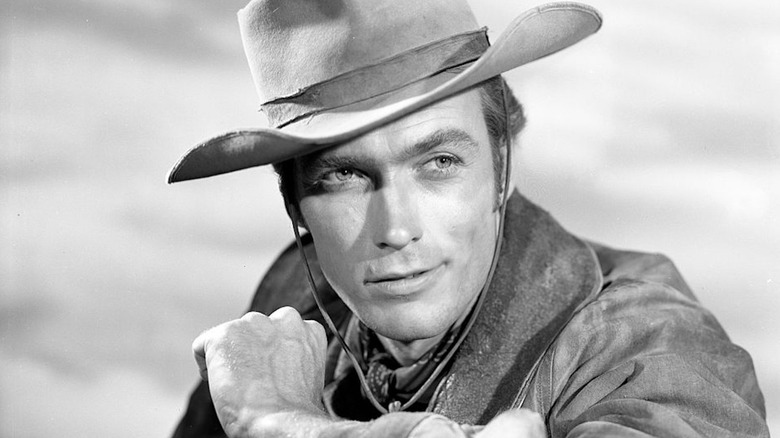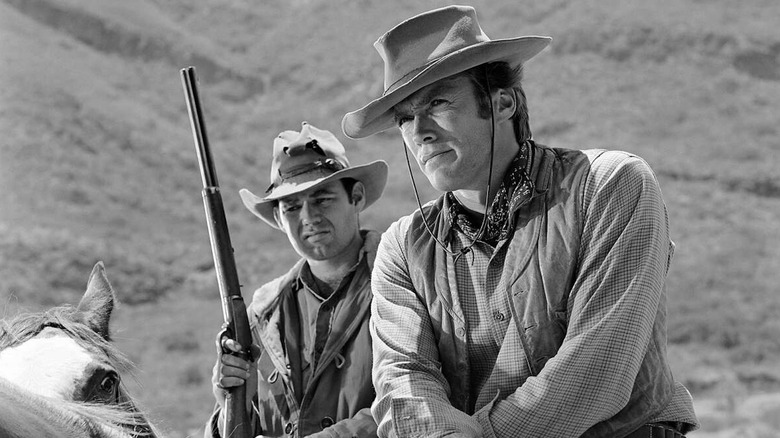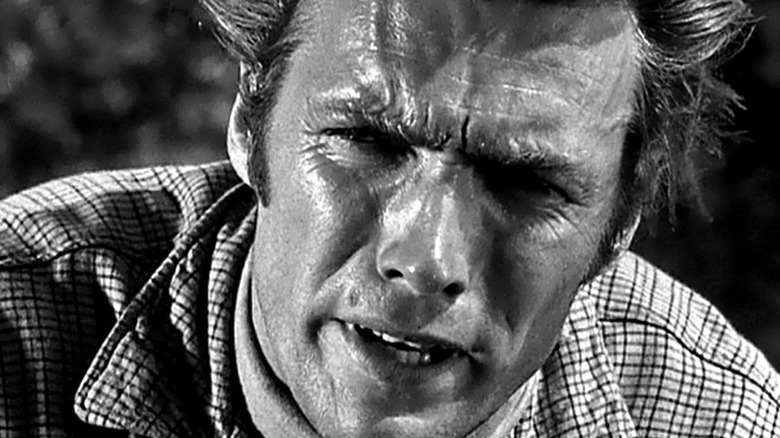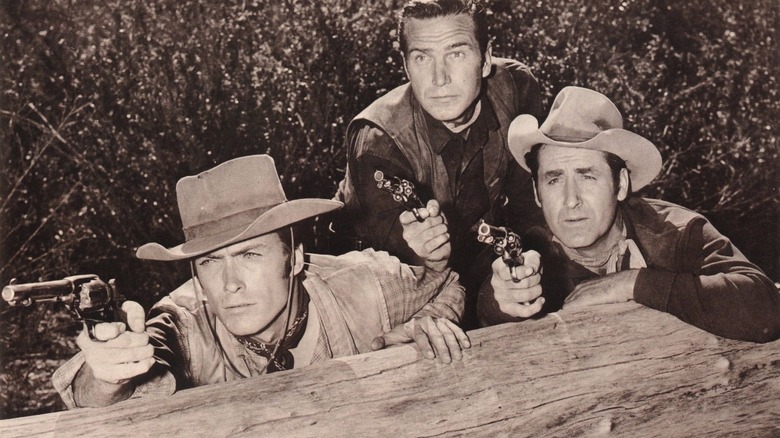How Rawhide Started Clint Eastwood Down The Path To Becoming A Director
Clint Eastwood began his acting career in 1955, a year he would appear (uncredited) in the Universal monster movie "Revenge of the Creature" as well as the TV movie "Allen in Wonderland," wherein he played a hospital orderly. After four years of supporting roles and guest spots in movies and on TV, Eastwood landed his first notable starring role, playing the character of Rowdy Yates on the massively popular Western TV series "Rawhide." The hour-long drama debuted in January of 1959 and ran a then-unprecedented 217 episodes, finally going off the air in 1965.
"Rawhide" followed the many adventures of actual cowboys — that is, the ones that handle cattle — as they faced off against rustlers and other criminals. Rowdy Yates was the young hothead of the group and had to learn how to mature over the course of the series. Eastwood was 28 at the time but was already honing the type of intense roles he would come to be associated with later in his career.
Even in those early days of "Rawhide," however, Eastwood was already considering directing. Eastwood's debut as a director wouldn't come until 1971 with the feature film "Play Misty for Me," but it seems the impulse to orchestrate shots and "workshop" scenes with his fellow actors was an instinct he followed from the start.
In the 1999 interview book "Clint Eastwood: The Interviews," edited by Robert E. Kapsis and Kathie Coblentz, Eastwood spoke about how shooting one particular stampede sequence for "Rawhide" got him thinking that he could film it better.
Union rules
While talking to interviewer Patrick McGilligan, Eastwood recalled the very moment while filming "Rawhide" that had him considering direction. It seems it was something he had always wanted to try regardless, but then began actually brainstorming ways to film a scene in a more dynamic way than TV budgets in the 1950s would allow. Eastwood felt that the cow action would be far more exciting if it were filmed from within the herd. In his words:
"When I was up on location one time, we were shooting some vast cattle scenes — about two thousand head of cattle. We were doing some really exciting stampede stuff. I was riding along in the herd, there was dust rising up, and it was pretty wild, really. But the shots were being taken from outside the herd, looking in, and you didn't see too much. I thought, we should get right in the middle of this damn stampede."
"Rawhide" was shot on 35mm film, and while Steadicams weren't invented yet (the first film to use a Steadicam was "Bound for Glory" in 1976), there were portable Arriflex cameras that could have been hoisted onto horseback. Eastwood was experienced enough to know this and wanted to get some shots himself. He said:
"I said to the director and producer, "I'd like to take an Arriflex, run it on my horse and go right in the middle of this damn thing, even dismount, whatever — but get in there and really get some great shots, because there are some beautiful shots in there that we are missing.' Well, they double-talked me. They said, 'you can't get in there because of union rules' — which isn't true at all, because if you're doing a shot the normal camera operator can't do[...]"
You can do the trailers
A lot of the stampede shots in "Rawhide" were achieved through the use of cranes, as one might see in on-set photographs online. A crane would be hoisted over a herd of cattle and shoot down into the bustling animals. Eastwood, in actually riding on horseback next to the cattle, knew that his own personal point of view was better than the cranes looking down.
By wanting more POV shots, he was already becoming a director. Eventually, he would approach his co-star, Eric Fleming, about the possibility of doing it for real. He wanted Fleming, the top-billed star of "Rawhide," to give his blessing before he went to the producers. Eastwood was dismayed to learn that the producers weren't so keen on the idea. He said:
"I asked Eric Fleming, 'Would you be adverse to my directing?' He said, 'Not at all, I'd be for it.' So I went to the producer and he said great. Evidently he didn't say great behind my back; but he said great at the time. He said, 'I'll tell you what, why don't you direct some trailers for us; coming attractions for next season's shows?' I said, 'Terrific. I'll do it for nothing and then I'll do an episode.' And I did the trailers."
Actors becoming directors on their own hit shows is now a common practice, and one can see actors turning to directing more consistently as a result. Such a practice was still in its nascency in the 1950s and early 1960s, but there was already competition. It seems that Eastwood, the "new kid" on the show, was being muscled out by bigger stars who, it seems, sucked at the job.
Delaying the inevitable
So Eastwood was dismayed to learn that, in brief, he wasn't a big enough star to be considered for directing, and that when actors direct, it tended to go poorly (at least at the time). After the rejection, he didn't push further, saying:
"[T]hey reneged on the episode because, at that time, several of their name actors on other television shows were directing episodes, not too successfully. So about the time I was getting set to do it, CBS said no more series actors could direct their own shows. So I called it a day."
At the conclusion of "Rawhide," Eastwood moved into a series of feature films that would earn him worldwide cinematic acclaim, namely: Sergio Leone's celebrated Man with No Name trilogy. Still wanting to be more closely in charge of production, Eastwood managed to make a deal that would allow him to, if not direct, at least have some direct input into the script. Eastwood was allowed to do so because, as he recalled, the translation of the script from its original Italian was a little awkward. In his words:
"Then I went to work with Sergio Leone. He didn't speak any English, I didn't speak any Italian. So my agreement with the producer of the show was that I could rewrite the story. The stories were all the same, but the dialogue was terrible because it was interpreted by an Italian into English. I said, 'You've got to let me rewrite some of this stuff.' They said, 'Fine.' So I got more actively involved in the production over there."
The rest, as they say, is history. Eastwood became a capital-letters Movie Star and has since directed 40 features. The "Rawhide" producers, it seems, only delayed the inevitable.



